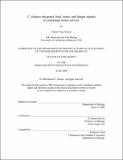C. elegans integrates food, stress, and hunger signals to coordinate motor activity
Author(s)
Omura, Daniel Togo
DownloadFull printable version (11.44Mb)
Alternative title
Cerevisiae elegans integrates food, stress, and hunger signals to coordinate motor activity
Other Contributors
Massachusetts Institute of Technology. Dept. of Biology.
Advisor
H. Robert Horvitz.
Terms of use
Metadata
Show full item recordAbstract
In the presence of a bacterial food source, the small nematode C. elegans greatly reduces its rate of locomotion. While mechanical agitation greatly stimulates the locomotion of well-fed animals on bacteria, it does not greatly stimulate the locomotion of food-deprived animals on bacteria. Thus, the competing effects of food and mechanical agitation on the animal's locomotory behavior are modulated by food deprivation. To explore how C. elegans modulates its locomotion we focused on determining how C. elegans detects bacteria, and explored the roles of biogenic amines, metabolic, and stress signaling pathways on this behavior. We correlated specific sensory defects and the expression patterns of genes involved in sensory function, gathered by the community of C. elegans researchers, with abnormal responses to a bacterial food source. Our findings suggest that a soluble component of the bacterial lawn is detected by the ASH and ASE chemosensory neurons and acts to suppress locomotion, while a volatile component of the bacterial lawn is redundantly detected by multiple chemosensory neurons and acts to maintain or stimulate locomotion on bacteria. In collaboration with Damon Clark and Aravi Samuel at Harvard University, we developed an automated locomotion tracking system that greatly improves the resolution at which we can study C. elegans locomotion. Using this system, we uncovered excitatory and inhibitory effects of serotonin on C. elegans locomotion and found that serotonin, dopamine, octopamine, and tyramine regulate the actions of one another. We also found that dopamine is required to set and maintain a precise rate of locomotion by C. elegans. (cont.) We observed that mutants defective in dopamine signaling make crude adjustments to their speeds that result in large fluctuations in their rates of locomotion. Treatment of dopamine deficient mutants with exogenous dopamine completely rescues these locomotion defects. Removal of tyramine and octopamine together partially suppressed these defects. We also studied how food-deprivation changes the animal's response to bacteria and mechanical agitation. We found that presumptive metabolic signaling through the C. elegans insulin receptor homolog daf-2 and stress signaling through octopamine converge on the neuropeptide Y receptor homolog npr-1 to modulate the animal's responses to food, mechanical agitation, and food-deprivation.
Description
Thesis (Ph. D.)--Massachusetts Institute of Technology, Dept. of Biology, 2008. This electronic version was submitted by the student author. The certified thesis is available in the Institute Archives and Special Collections. Includes bibliographical references.
Date issued
2008Department
Massachusetts Institute of Technology. Department of BiologyPublisher
Massachusetts Institute of Technology
Keywords
Biology.